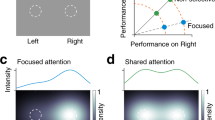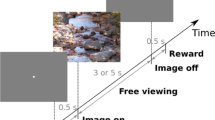Abstract
Visual selection is thought to be guided by both bottom-up intrinsic visual saliency and top-down visual attention. We examined how the relative importance of each of these processes dynamically changes over the course of a visual search in area V4 of two macaque monkeys. The animals were trained to perform a multidimensional visual search task in which a search array that consisted of two singleton stimuli, unique in shape and color, and four nonsingleton stimuli was presented. The task was to select one of the singletons as the saccade target, depending on the instructed search dimension, which was switched between shape and color. The strengths of the neural modulations caused by the bottom-up and top-down factors were, respectively, evaluated by assessing the dependence of the visual responses on the singleton type and the behavioral significance of the receptive field stimulus. We found that the initial visual responses of V4 neurons predominantly specified the singleton type of the receptive field stimulus, while the late presaccadic response primarily specified its behavioral significance. For comparison, recordings were also made from the frontal eye field (FEF) of one monkey and we found that the predominant activity of FEF neurons signaled the behavioral significance of the receptive field stimulus over time. These findings suggest that area V4 might function as an intermediate stage where both sensory- and behavior-based signals are dynamically represented, depending on their online requirements during a visual search, whereas the FEF predominantly represents behavior-based signals for upcoming saccade responses.






Similar content being viewed by others
References
Bacon WF, Egeth HE (1994) Overriding stimulus-driven attentional capture. Percept Psychophys 55:485–496
Baizer JS, Ungerleider LG, Desimone R (1991) Organization of visual inputs to the inferior temporal and posterior parietal cortex in macaques. J Neurosci 11:168–190
Basso MA, Wurtz RH (1997) Modulation of neuronal activity by target uncertainty. Nature 389:66–69
Bergen JR, Julesz B (1983) Parallel versus serial processing in rapid pattern discrimination. Nature 303:696–698
Bichot NP, Chenchal Rao S, Schall JD (2001) Continuous processing in macaque frontal cortex during visual search. Neuropsychologia 39:972–982
Bichot NP, Rossi AF, Desimone R (2005) Parallel and serial neural mechanisms for visual search in macaque area V4. Science 308:529–534
Bruce CJ, Goldberg ME (1985) Primate frontal eye fields. I. Single neurons discharging before saccades. J Neurophysiol 53:603–635
Bruce CJ, Goldberg ME, Bushnell MC, Stanton GB (1985) Primate frontal eye fields. II. Physiological and anatomical correlates of electrically evoked eye movements. J Neurophysiol 54:714–734
Chelazzi L, Duncan J, Miller EK, Desimone R (1998) Responses of neurons in inferior temporal cortex during memory-guided visual search. J Neurophysiol 80:2918–2940
Chelazzi L, Miller EK, Duncan J, Desimone R (2001) Responses of neurons in macaque area V4 during memory-guided visual search. Cereb Cortex 11:761–772
Connor CE, Egeth HE, Yantis S (2004) Visual attention: bottom-up versus top-down. Curr Biol 14:R850–R852
Connor CE, Preddie DC, Gallant JL, Van Essen DC (1997) Spatial attention effects in macaque area V4. J Neurosci 17:3201–3214
Contantinidis C, Steinmetz MA, (2001) Sneuronal responses in area 7a to multiple stimulus displays: I. Neurons encode the location of the salient stimulus.Cereb Cortex 11:581–591
Desimone R, Duncan J (1995) Neural mechanisms of selective visual attention. Annu Rev Neurosci 18:193–222
Desimone R, Schein SJ (1987) Visual properties of neurons in area V4 of the macaque: sensitivity to stimulus form. J Neurophysiol 57:835–868
Deubel H, Schneider WX (1996) Saccade target selection and object recognition: evidence for a common attentional mechanism. Vision Res 36:1827–1837
Efron B, Tibshirani R (1993) An introduction to the bootstrap. Chapman & Hall, New York
Egeth HE, Yantis S (1997) Visual attention: control, representation, and time course. Annu Rev Psychol 48:269–297
Fischer B, Boch R (1981a) Enhanced activation of neurons in prelunate cortex before visually guided saccades of trained rhesus monkeys. Exp Brain Res 44:129–137
Fischer B, Boch R (1981b) Selection of visual targets activates prelunate cortical cells in trained rhesus monkey. Exp Brain Res 41:431–433
Folk CL, Remington RW, Johnston JC (1992) Involuntary covert orienting is contingent on attentional control settings. J Exp Psychol Hum Percept Perform 18:1030–1044
Fuchs AF, Robinson DA (1966) A method for measuring horizontal and vertical eye movement chronically in the monkey. J Appl Physiol 21:1068–1070
Gottlieb JP, Kusunoki M, Goldberg ME (1998) The representation of visual salience in monkey parietal cortex. Nature 391:481–484
Haenny PE, Maunsell JH, Schiller PH (1988) State dependent activity in monkey visual cortex. II. Retinal and extraretinal factors in V4. Exp Brain Res 69:245–259
Hamker FH (2004) A dynamic model of how feature cues guide spatial attention. Vision Res 44:501–521
Hanes DP, Schall JD (1996) Neural control of voluntary movement initiation. Science 274:427–430
Hoffman JE, Subramaniam B (1995) The role of visual attention in saccadic eye movements. Percept Psychophys 57:787–795
Itti L, Koch C (2000) A saliency-based search mechanism for overt and covert shifts of visual attention. Vision Res 40:1489–1506
Judge SJ, Richmond BJ, Chu FC (1980) Implantation of magnetic search coils for measurement of eye position: an improved method. Vision Res 20:535–538
Kim MS, Cave KR (1999) Top-down and bottom-up attentional control: on the nature of interference from a salient distractor. Percept Psychophys 61:1009–1023
Koch C, Ullman S (1985) Shifts in selective visual attention: towards the underlying neural circuitry. Hum Neurobiol 4:219–227
Kowler E, Anderson E, Dosher B, Blaser E (1995) The role of attention in the programming of saccades. Vision Res 35:1897–1916
Lamy D, Egeth HE (2003) Attentional capture in singleton-detection and feature-search modes. J Exp Psychol Hum Percept Perform 29:1003–1020
Lee TS, Yang CF, Romero RD, Mumford D (2002) Neural activity in early visual cortex reflects behavioral experience and higher-order perceptual saliency. Nat Neurosci 5:589–597
Luck SJ, Chelazzi L, Hillyard SA, Desimone R (1997) Neural mechanisms of spatial selective attention in areas V1, V2, and V4 of macaque visual cortex. J Neurophysiol 77:24–42
Maunsell JH, Sclar G, Nealey TA, DePriest DD (1991) Extraretinal representations in area V4 in the macaque monkey. Vis Neurosci 7:561–573
Mazer JA, Gallant JL (2003) Goal-related activity in V4 during free viewing visual search. Evidence for a ventral stream visual salience map. Neuron 40:1241–1250
McAdams CJ, Maunsell JH (1999) Effects of attention on orientation-tuning functions of single neurons in macaque cortical area V4. J Neurosci 19:431–441
McPeek RM, Keller EL (2002) Saccade target selection in the superior colliculus during a visual search task. J Neurophysiol 88:2019–2034
Moore T (1999) Shape representations and visual guidance of saccadic eye movements. Science 285:1914–1917
Moore T, Armstrong KM (2003) Selective gating of visual signals by microstimulation of frontal cortex. Nature 421:370–373
Moore T, Fallah M (2004) Microstimulation of the frontal eye field and its effects on covert spatial attention. J Neurophysiol 91:152–162
Moore T, Tolias AS, Schiller PH (1998) Visual representations during saccadic eye movements. Proc Natl Acad Sci USA 95:8981–8984
Moran J, Desimone R (1985) Selective attention gates visual processing in the extrastriate cortex. Science 229:782–784
Motter BC (1994) Neural correlates of attentive selection for color or luminance in extrastriate area V4. J Neurosci 14:2178–2189
Murthy A, Thompson KG, Schall JD (2001) Dynamic dissociation of visual selection from saccade programming in frontal eye field. J Neurophysiol 86:2634–2637
Nothdurft HC (1993) The role of features in preattentive vision: comparison of orientation, motion and color cues. Vision Res 33:1937–1958
Ogawa T, Komatsu H (2004) Target selection in area V4 during a multidimensional visual search task. J Neurosci 24:6371–6382
Pashler H (1988) Cross-dimensional interaction and texture segregation. Percept Psychophys 43:307–318
Posner MI, Snyder CR, Davidson BJ (1980) Attention and the detection of signals. J Exp Psychol 109:160–174
Reynolds JH, Chelazzi L, Desimone R (1999) Competitive mechanisms subserve attention in macaque areas V2 and V4. J Neurosci 19:1736–1753
Schall JD, Hanes DP, Thompson KG, King DJ (1995a) Saccade target selection in frontal eye field of macaque. I. Visual and premovement activation. J Neurosci 15:6905–6918
Schall JD, Morel A, King DJ, Bullier J (1995b) Topography of visual cortex connections with frontal eye field in macaque: convergence and segregation of processing streams. J Neurosci 15:4464–4487
Schall JD, Thompson KG (1999) Neural selection and control of visually guided eye movements. Annu Rev Neurosci 22:241–259
Schein SJ, Desimone R (1990) Spectral properties of V4 neurons in the macaque. J Neurosci 10:3369–3389
Schmolesky MT, Wang Y, Hanes DP, Thompson KG, Leutgeb S, Schall JD, Leventhal AG (1998) Signal timing across the macaque visual system. J Neurophysiol 79:3272–3278
Sheinberg DL, Logothetis NK (2001) Noticing familiar objects in real world scenes: the role of temporal cortical neurons in natural vision. J Neurosci 21:1340–1350
Spitzer H, Desimone R, Moran J (1988) Increased attention enhances both behavioral and neuronal performance. Science 240:338–340
Stanton GB, Bruce CJ, Goldberg ME (1995) Topography of projections to posterior cortical areas from the macaque frontal eye fields. J Comp Neurol 353:291–305
Theeuwes J (1991) Cross-dimensional perceptual selectivity. Percept Psychophys 50:184–193
Thompson KG, Bichot NP (2005) A visual salience map in the primate frontal eye field. Prog Brain Res 147:251–262
Thompson KG, Bichot NP, Sato TR (2005) Frontal eye field activity before visual search errors reveals the integration of bottom-up and top-down salience. J Neurophysiol 93:337–351
Thompson KG, Bichot NP, Schall JD (1997) Dissociation of visual discrimination from saccade programming in macaque frontal eye field. J Neurophysiol 77:1046–1050
Thompson KG, Hanes DP, Bichot NP, Schall JD (1996) Perceptual and motor processing stages identified in the activity of macaque frontal eye field neurons during visual search. J Neurophysiol 76:4040–4055
Treisman AM, Gelade G (1980) A feature-integration theory of attention. Cogn Psychol 12:97–136
van Zoest W, Donk M, Theeuwes J (2004) The role of stimulus-driven and goal-driven control in saccadic visual selection. J Exp Psychol Hum Percept Perform 30:746–759
Yarbus AL (1967) Eye movements and vision. Plenum, New York
Acknowledgements
We thank M. Togawa for technical assistance. Supported by Grants-in-Aid for Scientific Research for Young Scientists (B) from the Ministry of ECSST and Biological Information Technology Grant for Top Priority Research and Development to Be Focused from the Ministry of PMHAPT.
Author information
Authors and Affiliations
Corresponding author
Rights and permissions
About this article
Cite this article
Ogawa, T., Komatsu, H. Neuronal dynamics of bottom-up and top-down processes in area V4 of macaque monkeys performing a visual search. Exp Brain Res 173, 1–13 (2006). https://doi.org/10.1007/s00221-006-0362-5
Received:
Accepted:
Published:
Issue Date:
DOI: https://doi.org/10.1007/s00221-006-0362-5




